#Czech Technical University
Text
The diplomatic dispute between two of Europe’s most closely intertwined nations shows how Russia’s full-scale invasion of Ukraine has created new political and ideological fault lines in Central Europe.
In early March, the historian and founder of Czech-Slovak seminars at the Technical University of Liberec, Jan Rychlik, made a pretty well-established and consensual point: “Considering the vocabulary is 80 per cent identical, and the rest of the words are not exactly identical but mutually intelligible, there cannot be a situation where Czechs and Slovaks do not understand each other.”
Yet just a few days later, the two countries’ leaders appeared to be speaking very different languages.
On March 6, Czech Prime Minister Petr Fiala announced the suspension of the joint intergovernmental consultations held on a regular basis with Slovakia, including the next one that was originally planned for the month of April.
“Our place is in the Western community of nations,” Czech Foreign Minister Jan Lipavsky said in explaining the move. “The reason why we cancelled the intergovernmental consultations is that our views on the Russian aggression against Ukraine are radically different.”
Swiftly cast as an unprecedented move in the modern history of the two countries that split peacefully over 30 years ago, Prague’s decision to keep its distance from the new populist government of Robert Fico came less than two weeks after an uneasy Visegrad Group summit in the Czech capital saw Central European leaders scramble to agree to disagree on how to support Ukraine.
For Czechs, who along with Poland have pursued a clear policy of military and political support for Kyiv, the last straw appeared to have been the meeting between Slovakia’s pro-Russian foreign minister, Juraj Blanar, with his Russian counterpart Sergei Lavrov during a diplomatic forum in Turkey a few days before.
Tensions between the two sister nations had been growing for months since the political comeback last October of Robert Fico, elected on a – slightly misleading – pledge not to provide “a single bullet” to Ukraine, stop all military aid and push for a diplomatic solution to the conflict rather than help Kyiv fight back against Russia’s invasion.
Despite obvious differences, the two governments initially tried to smooth the relationship. “The fact that we have different foreign policy stands on some matters is nothing unusual. We respect each other’s right to mould an independent foreign policy,” Lipavsky said after holding talks with his Slovak counterpart in November – followed by a meeting between the prime ministers Fiala and Fico later that month. But the gap soon proved too wide.
Reversing Bratislava’s previous stance on the war to mimic Hungarian Prime Minister Viktor Orban’s self-declared “sovereigntist and pacifist” foreign policy, Fico went all-out to criticise Western support for Kyiv and EU sanctions against Russia, deplore the “demonisation” of Vladimir Putin, minimise the impact of the war in Kyiv, and blame Ukrainian neo-Nazis for starting the conflict.
“Without communication, there will never be a diplomatic solution, and without a diplomatic solution, no wars will end,” Blanar argued during his face-to-face with Lavrov, who incidentally is on the EU sanctions list, while Fico said the meeting showed Slovakia could proudly conduct a “balanced” foreign policy.
But many aren’t buying it. “[Ruling party] Smer members talk about peace, but their actions support pro-Russian narratives, including proposals for Ukraine to give up its own territory,” opposition MP Tomas Valasek argued.
The liberal opposition, along with outgoing President Zuzana Caputova and then-presidential hopeful Ivan Korcok, vocally accused the three-party coalition led by Smer of doing the Kremlin’s bidding and taking Slovakia further on the path of isolation, evidenced by its rift with its western neighbour.
“In the last 30 years, Slovakia has not threatened Europe as much as it does today,” reckons Jakub Janda, a defence analyst and head of the Prague-based European Values Center for Security Policy.
Fico – who, as irony would have it, was the one that established the intergovernmental consultations as prime minister back in 2012 with his then-counterpart Petr Necas – lashed out at the Czech government and accused Prague of sacrificing Czech-Slovak relations for ideological reasons and warmongering in Ukraine.
Multi-player dynamics
Although unique considering how closely intertwined the Czech and Slovak nations commonly are, the suspension of intergovernmental consultations should not be overblown, argue some analysts.
“Honestly, there’s a bit too much fuss on this topic. It’s not as serious as it is sometimes presented,” says Michal Vasecka, director of the Bratislava Policy Institute.
“It is unprecedented only in comparison with the exceptional relationship and high standards both countries have always had. It’s a signal that Czechia considers the Slovak government to be problematic and simply wants a standard relationship with them,” he tells BIRN.
Commenting on the rift, Czech Foreign Minister Lipavsky appeared to echo this observation: “We will certainly not summon our ambassador in Bratislava home for consultations. That would be a step that would mean that we have a fundamental crisis in relations and that is not the case,” he said, adding that Czechia and Slovakia simply “do not have that special moment in relations” right now.
Yet the immediate rift between the Czech government of Petr Fiala and Fico’s cabinet in Slovakia has revealed deeper trends at work, with Russia’s war against Ukraine working as a catalyst to spotlight political and ideological fault lines affecting the entire political class in both countries, and the region as a whole.
Nowhere was this more evident than after the Visegrad Group summit of late February, where the divisions between a Czech-Polish pro-Ukrainian hawkish axis and a Slovak-Hungarian illiberal “pacifist” line were already on full display.
After the summit, while Polish Premier Donald Tusk was received for talks by President Petr Pavel at the Prague Castle, Fico – whom Pavel had bluntly called “a disappointment even for many Slovaks” – and Orban headed for drinks and canapes with former Czech president and notorious Kremlin-accommodator Milos Zeman. The Hungarian premier also used his visit in Prague to meet with former prime minister Andrej Babis and another ex-head of state Vaclav Klaus, who himself was welcomed in Bratislava in March by Fico.
Ahead of last year’s general election, Babis, Klaus and Zeman – all vocal critics of the current Czech leadership – had openly expressed their support for Fico who, in April, went one step further in building bridges with the Czech opposition by receiving far-right agitator Jindrich Rajchl.
“Fico is clearly waiting and hoping for a change of government in Prague,” believes Michal Vasecka, hinting at next year’s parliamentary election which could see the return to power of Babis and his populist ANO party, whose shifting narrative on Ukraine bears some similarities with Fico’s own.
“Right now, the rhetoric we hear from Slovakia about peace and sovereignty and so on is something that will probably be well received by the electorate of Babis in the Czech Republic, because he feeds them the same diet,” confirms political analyst Jiri Pehe.
Which explains why the billionaire ex-premier, himself originally from Slovakia, became so directly invested in last month’s presidential campaign, travelling to Bratislava and throwing his support behind Fico ally and now-president elect Peter Pellegrini.
In contrast, Czech government officials could barely conceal their disappointment at the results. “The Czech political elite, at least those on the side of the governing coalition, are not very happy about the result of the [presidential] elections in Slovakia, simply because Pellegrini is just an extended arm of Robert Fico,” Pehe summed up on Czech Radio.
In Prague, too, officials appear to be less and less shy in showing their frustration with the Fico government. Just two days after suspending bilateral consultations, Fiala met with Slovakia’s liberal opposition leader Michal Simecka.
President Pavel, meanwhile, was quick to sign the official patronage for the 2024 Globsec Conference – a staple of Central European political and diplomatic gathering organised in Bratislava for the past 18 years and whose organisers have found themselves in Fico’s crosshairs – to be moved to Prague later this year.
Vanishing Central Europe
As far as Czech-Slovak bilateral relations go, Michal Vasecka from the Bratislava Policy Institute believes that things will likely remain as they are for now.
“The Czech government will continue supporting the Slovak opposition, and vice-versa,” he tells BIRN. “If nothing major happens, the rift could probably fade into the background for some time.”
And while there is “little risk” for the political dispute to spread to other spheres of bilateral relations and directly affect ordinary citizens, the possibility is still there, according to Vasecka, who points out that while pro-Russian sentiment is widespread in Slovakia, it is much more of a fringe phenomenon within Czech society.
“There is a real lack of trust, Czechs are viewing Slovaks with more suspicion than before. Most Czechs simply can’t understand why roughly half of Slovakia thinks the way they think, especially when it comes to anything Russia-related,” he says.
Czechia and Slovakia’s widely diverging stance on Russia shows – possibly to the dismay of some Western political commentators – that Central Europe’s shared Eastern Bloc and communist past did not lead to a homogeneous and monolithic democratic bloc created at the heart of the continent, especially considering both countries were united as one for about 80 years.
Along with Hungary, Slovakia was one of the very few EU countries to send its representative to attend Vladimir Putin’s fifth inauguration, at the beginning of May, as Russian president.
And while Czechia has been leading European-wide efforts to crack down on a Moscow-funded influence and propaganda network operating out of Prague, one of its main suspected architects, Artom Marchevsky, has found refuge in Slovakia since being added to the Czech sanctions list over a month ago.
“34 years on, Eastern Europe does not exist. The countries of the eastern half of the continent are as diverse of those of the western half of the continent,” the British historian Timothy Garton Ash argued.
“Central Europe encapsulates the divisions that we have in Europe as a whole,” he said, further making the case that the post-1989 era which followed the fall of the Berlin Wall “ended on February 24, 2022 with Vladimir Putin’s full-scale invasion of Europe”.
Looking at the current developments in Central Europe – and the ongoing brotherly feud between Czechia and Slovakia – this observation rings even truer.
And while acknowledging that the Visegrad Group of Central European nations “has already suffered clinical death several times before”, Michal Vasecka considers “this one to be the most serious yet”.
Testament to this growing distrust, local media Denik N reported in late April that Czechia – along with intelligence agencies from other Western countries – were carefully filtering which information to pass on to their counterparts in Slovakia for fear it might fall into the wrong hands. The clear penetration of the Hungarian intelligence services by Russia has meant for some years it is cut out of sensitive intelligence briefings by Western agencies.
Echoing Garton-Ash’s assessment, Pehe, a former advisor to Vaclav Havel, recently wrote that “it has gradually become clear that the political legacies of individual V4 countries contained more differences than what united them”, with Russia’s expansionism and the war in neighbouring Ukraine playing a key role in showcasing and exacerbating these divisions.
“If we return to [Czech writer Milan] Kundera’s central thesis, according to which Central Europe was the ‘abducted West’, current developments rather deny it,” with some governments like the ones currently in power in Hungary and Slovakia “voluntarily distancing themselves from the West”.
This leads the long-time Czech commentator to sombrely note: “The Central Europe that Kundera dreamed of and that the politicians of the first post-1989 generation wanted to revive politically is disappearing before our eyes.”
8 notes
·
View notes
Photo



Ota Janeček, Czech painter, illustrator and sculptor (1919 - 1996).
Between 1938 and 1942 he studied at the Technical University and at the School of Applied Art in Prague. In 1943 he became a member of the Manes Union of Artists and in 1945 of the Hollar Society of Czech Artists. In the 1940s he produced a number of paintings of female figures in the style of Modigliani.
Later his work became realistic, he made a lot of drawings and illustrations. By the 1950s his work began to show the influence of P.Klee and G.Seurat, which inspired him to create special colour effects. These effects became a permanent feature of his work. Inspired by nature he created the cycles Grasses, Flore and Organism. In his last creative period Janecek arrived at a kind of synthesis of all his cycles and previous themes, which reflected his personal colouring and lyricism.
https://www.widewalls.ch/artists/ota-janecek
29 notes
·
View notes
Photo
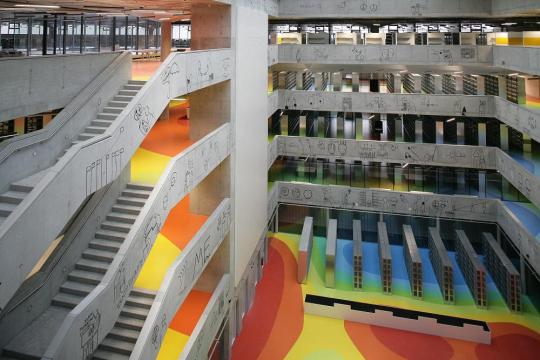


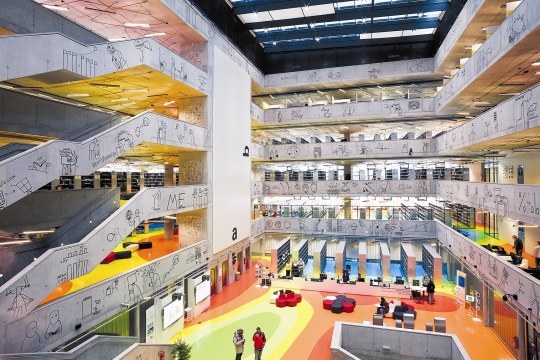

With a collection of around 926,000 volumes, the National Technical Library is the largest library of technical literature in the Czech Republic. Its new building, built since 2006 and opened on September 9, 2009, is located in Dejvice, Prague 6, in the area of technical universities and other institutions called the Dejvice Campus.
https://www.techlib.cz/en/
#book#books#prague#prag#czech republic#Czechia#library#technical#literature#bookworld#bookwarm#nationallibrary
12 notes
·
View notes
Video
youtube
Ayşegül Sarıca (1935-2023)
Ayşegül Sarıca was born in Istanbul in 1935. She began learning piano from Ferdi Statzer at the Istanbul Municipal Conservatory. After finishing school, she went to Paris in 1951, and studied piano with Lucette Descaves and chamber music with Pierre Pasquier at the National Conservatory in Paris. After graduating conservatory in 1953, Sarıca worked with Marguerite Long. In 1959, Sarıca won the “Prix de la Ville de Paris” at the M. Long-Jacques Thibaud International Competition.
She has given many concerts with famous conductors such as Karel Ancerl, Pierre Dervaux, Anatole Fistoulari, Louis Fourestier, Gotthold Lessing and Heinz Walberg in many countries: England, France, Italy, Germany, Spain, Austria, Belgium, Russia, Poland, Rumania, Hungary, Czech Republic, Switzerland, Norway, Finland, Egypt, Tunis, Algeria, Iran, UAE, China, Japan, Taiwan, Singapore and Australia. Since 1968, Sarıca has been a soloist of the Presidential Symphony Orchestra. She received the title of the State Artist in 1971. In 1974, she received the “Chevalier de I′Ordre des Arts et des Lettres” from the French Ministry of Culture. Sarıca has also given numerous recitals with many virtuosos such as Christian Ferras, Andre Navarra, Heinrich Schiff and Alexander Rudin.
In 1991, Sarıca played Cemal Reşit Rey’s “Kâtibim” with the Hungarian State Symphony Orchestra, conducted by Hikmet Şimşek. It was recorded onto the disc. Among her CDs are: violin-piano sonatas of Grieg, Debussy and Frank (with violinist Ayla Erduran); Mozart’s Symphony No.15 and No.23 (with Ankara Chamber Orchestra, conducted by Gürer Aykal); Beethoven’s Concerto No.3 and No.4 (with the Presidential Symphony Orchestra) and Schumann’s Piano Concerto in A minor (with Bilkent Symphony Orchestra). In addition, her recitals were also recorded onto the disc, which is including Moments Musicaux series.
Between 1991 and 2000, Sarıca taught master courses to students in the Faculty of Music and Stage Arts at Bilkent University. Since 1999, she has taught master and doctoral courses to students in the Institute of Advanced Research on Music at Istanbul Technical University. In 2006, Sarıca was awarded the “Merit of Honor" in music by the Istanbul Culture and Art Foundation. She has served as a jury member in numerous international piano contests.
13 notes
·
View notes
Note
behind the scenes for wait a year (which i just reread and continue to be delighted by)
okay this is technically a little less than half of this scene but the full scene is almost 4k (it's by far the longest scene in this story, almost a quarter of the story is this scene) but here's some commentary on the part before they start actively having sex, lol
The most surreal thing that happens in Prague is that they win, [truly this is one of the most improbable and self-indulgent things i've ever put into a hockey fic. tho the original outline of this story had them winning gold at the 2026 olympics together and then i realized i'd lose my mind writing two different fics in two different versions of 2026, and that i'd have to fill three and a half whole years of story in] an overtime goal shoveled in on a rebound by a kid named Ryan Chesley that Luke played with in Michigan [i thought this was a real guy for some reason but the only ryan chesley i can find plays for the university of minnesota ... who knows] and who spent the first week of the tournament sitting next to Quinn at every meal to ask him questions about the NHL. Quinn’s on the ice with him when the puck goes in, the horn goes, the arena full of Czech fans goes suddenly silent except for the screaming directly in Quinn’s ear. [my sincere apologies to the czech men's national ice hockey team and also their faithful fans attending the game. i do feel bad but they had to beat someone]
It still feels great to be slammed into the boards by the weight of his whole team, and as the cheers on the ice start to die down Quinn can hear a few from the crowd, too. And it’s still a win, a gold medal that’ll be draped around all their necks, another item for the list of things he and Brady have done together.
Quinn stands next to Brady when they line up for the anthem, Brady’s arm draped over his shoulder and Brady’s voice loud in his ear. Quinn leans in closer, unable to resist the pull of him, and Brady tightens his arm around Quinn’s shoulders as the final notes of the anthem play, and it’s like something out of a dream. [brady is SO physically affectionate and i spent a lot of time really carefully threading this needle of making him even more obviously so than usual and still keeping quinn unaware of brady amping it up] A weird hybrid of present and memory that comes together as feeling entirely outside of reality.
After—after the medal ceremony, after the champagne and beer in the locker room, after the team shuffles through a series of bars, after Quinn tries more Czech beers than he thought existed—after all that, Brady catches his eye and grins and Quinn follows him out onto the street without a second thought. [i didn't want quinn to seem like a pushover in this story, or like he isn't an active participant in this relationship or friendship because he very much is, but he is willing to let brady be in charge of things pretty often, and brady also knows him very well and makes sure things are the way quinn would want them. because he's in love] He doesn’t even know what Brady has in mind. The smell is wearing on Quinn, the walls and wooden seats oozing smoke even though no one inside is smoking, and the air outside is crisp and clear. [i learned many facts about prague for this fic and one of them was that smoking in restaurants was only banned there pretty recently]
Prague is pretty cool, with red-roofed buildings and old, winding streets and stone bridges arching over the river. [google search pictures of prague] Quinn wouldn’t mind actually getting to explore instead of being shuffled from the hotel to the arena to the practice facility.
Brady knocks his shoulder against Quinn’s, startling him out of his thoughts. “I think I’m just about done for the night,” he says. “I can’t keep up with those kids anymore.” [this is a lie. brady can keep up with the kids. he's just more interested in having sex with quinn. or going for a walk with quinn. really whatever as long as quinn is there]
He doesn’t seem particularly drunk, to be honest. Quinn’s seen him drunker, Quinn’s seen him puking in bushes and falling asleep in strangers’ beds. Right now he’s a little pink in the face, but he isn’t slurring or stumbling or even rambling. It is late, though, and they played a hard game today, 12 minutes of overtime before the goal horn sounded. And Quinn’s had a lot of beer, even if he isn’t really feeling it either. Maybe in the tips of his fingers, but maybe that’s just Brady’s proximity and the way Quinn wants to reach for him. [quinn ... you're so in love]
There’s no one around who would even notice if he did.
“Me neither,” he says. “You gonna head back to the hotel?”
Brady nods. “I think we could walk,” he says. “I don’t think it’s far.”
It’s a clear night, stars sprinkled through the sky and a crescent moon overhead. According to Google Maps on Brady’s phone, the walk back to the hotel will take 20 minutes and take them across one of the bridges. The night air feels nice after so many hours of sweaty teammates and cramped, hot bars and beer breath. [this is very Rule of Romantic, i feel like a cab would be much more plausible but a tipsy nighttime stroll in the moonlight ... so good for being in love]
Halfway across the bridge, Brady nudges Quinn’s shoulder again, and then he catches Quinn’s hand in his own. [this scene, and the one shortly after where they go out to dinner, are both very much meant to feel like what the relationship progression would've been if they started dating in high school, going for walks together and tentatively holding hands etc] He’s never done that before. Quinn refuses to read anything into it. It’s just Brady doing that thing where he doesn’t know how to be casual.
On the other side of the bridge, half a block down an empty cobblestone street, Brady presses him against a wall and kisses him. It’s not really a surprise, not after last summer, but it feels completely different. This isn’t part of Quinn’s life. He might never come back to this city, and even if he does come back here, probably for some other IIHF tournament at some point, he might never walk down this street again. He isn’t going to walk past this spot and think about the time Brady kissed him here, the way Brady’s mouth moved against his and the warmth of Brady’s hand on his side, distracting even through the material of Quinn’s shirt. [is this a good thing or a bad thing? quinn's not sure yet]
Quinn kisses him back, of course, slides his mouth across Brady’s and his hand along Brady’s side. The stone is cool against his back, and Brady’s mouth is forceful against his. Not rough, not biting, but Quinn would have to push him away to break the kiss.
He doesn’t want to push Brady away, and when Brady does pull away, Quinn chases his mouth. Brady indulges him with another kiss, shorter and softer, and then kisses his cheek instead. [brady ... this boyfriend behavior ...]
“Wanted to do that since you set Chesser up with that saucer in OT,” Brady says, and his breath is hot against Quinn’s cheek. [a fun fact about me is that i cannot use sauce in the slang sense of pass in any way with a straight face and i did in fact grimace as i wrote this line but. these dumb boys do say these things] The problem, the one that Quinn’s been trying to ignore since the first moment that Brady laughingly suggested kissing him, is the one that Quinn always knew was simmering under the surface: the moment Brady became someone he might be able to have, he stopped wanting anyone else. [oh i was so proud of this line. i am proud of it tbh! obviously it's not consciously in quinn's internal monologue throughout the story but i hope the idea was kind of infused in so it doesn't come totally out of left field]
Quinn tangles his hand in Brady’s hair as best he can, and yanks Brady’s mouth back to his. Brady lurches forward, and the medal hanging around his neck hits Quinn’s chest before it settles, dangling between them. [is this how physics works? i sure hope so] Quinn doesn’t like the space there, and he arches off the wall to feel Brady’s chest against his own instead.
He kissed Brady so much last summer, but he’s still not used to kissing someone that much taller than him, the way he has to tilt his head up, how much longer Brady’s limbs are than his own. He’s not used to it, but he does like the way Brady towers over him, corners him against the wall, presses forward until Quinn’s entirely surrounded by him. [tying back to brady right after the game, draped all over quinn, always touching him :))))] He’s not used to it but part of him wants to be, wants to get to do this until it starts to feel normal.
Now’s not the time to think about that. Now’s the time to kiss Brady until his lips are sore, until they’re both panting, and then to slide his hand down to Brady’s ass and squeeze hard enough that he understands what Quinn wants out of this.
It also makes Brady’s hips hitch forward against his, rough friction for a few breaths, and Quinn doesn’t even bother trying to hide the way it makes him gasp. It’s not like Brady doesn’t know what he likes.
Brady bites Quinn’s earlobe before he pulls away, and then scrapes his teeth down the side of Quinn’s neck. Quinn didn’t used to like having this much biting involved in sex, but it’s Brady. So far, he hasn’t found anything he doesn’t like when it’s with Brady. [quinn ... buddy ... more broadly i really enjoy poking at concepts like the things people do because the person they love wants them, someone else being so into something that you enjoy it even if it's not your thing, etc etc. not a lot of detail on it in this story but it was def on my mind]
“You wanna head back to the hotel?” Brady asks. His voice is rough. Quinn squeezes his ass again. Watches Brady’s eyes fall shut for a moment. “Jesus,” he says. [quinn does really enjoy getting to throw brady a little off balance]
“Yeah, I wanna go back to the hotel,” Quinn says. He doesn’t sound any better than Brady.
“Thank God,” Brady says. And then he kisses Quinn again, stepping somehow closer so that Quinn is more thoroughly pinned but also so that they’re pressed together, almost hip to hip. Quinn rolls his hips a couple of times to feel the drag of his cock on the inside of his pants. Not what he wants but better than nothing at all, and it’s pretty satisfying when it makes Brady swear under his breath, too.
“Fuck,” Brady mumbles. “I gotta—”
He fumbles for his phone in his back pocket.
Matthew was still at the bar when they left, and Brady must be texting him to find somewhere else to crash. Maybe in the morning they’ll regret giving him that kind of ammunition, [matthew's inclusion in this story is partially just a function of it being a gift for becky, though also partially as a brothers counterpoint to jack, but i did amuse myself imagining what a nightmare he'd be to brady about this] but right now Quinn just wants to get his hands on Brady’s skin, his mouth on the muscles of Brady’s stomach, the thin skin of his hips and collarbone, the tender spots on his neck. He spent the whole season trying not to remember how well he learned Brady’s body last summer, but it’s all rushing back now. Brady’s hand is already curled around his hip, fingers pushing under the waistband of Quinn’s pants, nails scraping a tender spot above his hip where he would leave marks with his mouth and then push his thumb into them until Quinn hissed. [being familiar with someone's body ... good]
“Come on,” Quinn says, pushing Brady away from him. There are things Quinn wants to do to him—with him—that he’s not going to do on a side street in Old Town Prague, even after midnight when there’s no one around. He does not want to have to call his parents, or worse, Matthew, to explain that they got arrested for public indecency in Czechia. [this would be a nightmare for them but very funny for me]
“Right,” Brady says. He’s distracted, his hand sliding from Quinn’s hip to his ass, fully under his pants now.
“Brady,” Quinn hisses. “Hotel. We can be naked in a hotel.”
That does get a pleased noise out of Brady, and then a transparent leer.
“You know, you’re hotter now than you were when I said I’d marry you,” Brady says. [i don't think of brady as a particularly self-aware guy, which tangentially is why i find his pov really hard to write, and to some extent he isn't entirely aware of what he's going with quinn in this fic. he gets there quicker, and he's fully willing to go with the flow of stumbling into a relationship, but he is very much in the middle before he realizes he's begun, as it were. but the pin drops for him like ... on their romantic prague vacation] Quinn absolutely cannot think about this. He cannot think about marrying Brady, the stupid deadline that creeps closer every year, and then go to a hotel in Prague and beg Brady to fuck him. [oh but you very much can, quintin] “Good taste from me, I think,” Brady continues. “Got in there before anyone else did.”
9 notes
·
View notes
Text
Nobu Performs at the Seattle Symphony and I subsequently cry my eyes out
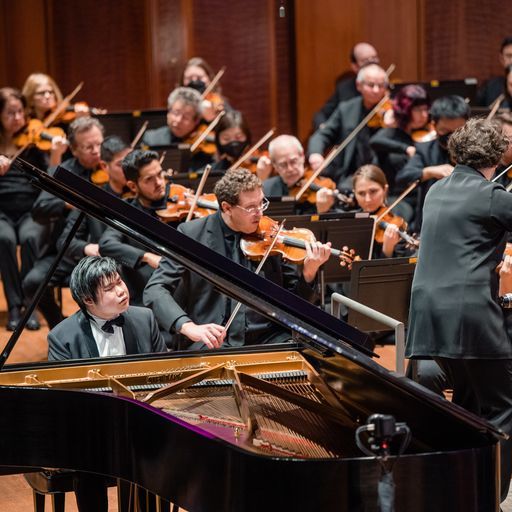
There is nothing quite like the solidarity that you get from silently wiping away your tears at the symphony as the fellow next to you does the same thing. I think Rachmaninoff just has that effect on people.
I went to see Rachmaninoff’s Piano Concerto No. 2 on January 28th, performed by Nobuyuki Tsujii (also referred to as Nobu by his fans) on the piano and the Seattle Symphony conducted by Jiří Rožeň. I hadn’t realized how famous Tsujii was until I showed up to Benaroya Hall. It was a packed house with a lot more people my own age in attendance than what you typically see with the usual symphony crowd. Despite my ignorance about Nobu’s notoriety, I was about to discover the reason for this justifiable fame soon enough. Nobu’s dynamic sensitivity was absolutely sublime, at times it seemed his fingers were merely brushing against the keys and then, just moments after, he would bring the piano up to its full capacity, all the while not sacrificing any clarity. It would be remiss to not mention that Nobu is fully blind, which makes his talent all the more awe-inspiring, given that he has to commit everything he plays to memory without the use of sheet music and goes purely off of listening to specialized recordings. As for the choice in music, it resonated perfectly with me in my current state. As someone who often finds themselves struggling with the blight of seasonal affective disorder in the Seattle winters, reading the program about how Rachmaninoff wrote his second concerto as he was exiting a depression made the music feel like a deliverance. The encore was an etude by Nikolai Kapustin, and I always feel my ego puff up a bit when I can recognize the encore, since it is not listed in the program and the pianist often doesn’t say what they've just played. I could truly appreciate the level of Nobu’s virtuosity with the Kapustin etude, as I had since recovered from the emotional journey Rachmaninoff had put me through, and my vision was no longer blurred by my tears.
Nobu’s performance was sandwiched between two beautiful works by Czech composers. The conductor, Jiří Rožeň, who specializes in works by Czech composers, led the charge with Dvořák’s Carnival Overture. I had never heard the piece prior to this performance, but it was delightful all the same. The night was closed out with Martinů’s Symphony No. 6, which was also new to me, but seemed to be in keeping with what I have heard from the composer in the past. The dissonance that Martinů employs often makes me think, “oh god that’s awful, I love it.” The joy of going to the symphony is that it is consistently introducing me to new pieces, even though I usually only buy tickets for the shows that are headlined by works that I already know.
Every so often, living in the Seattle area graces me with the opportunity to see a world class musician. I’m not entirely sure how to capture what I mean by “world class,” but I do know that it is a rare virtuosity, and outside of just technical perfection, it is a performance that has emotional breadth. I’m not particularly religious but sometimes it seems to me that some musicians have been sent down from on high. Perhaps they are connecting to a universal plane that is always there, but only occasionally tapped into. I experience shivers that start at the top of my head and travel to the tips of my fingers, and if that in itself is not a religious experience, I'm not sure what is. I felt it when I saw Daniil Trifonov perform back in November, and then again with Nobuyuki Tsujii. I am beyond excited for Rach Fest which is coming up in April. If you plan on attending, remember to wear waterproof mascara.
Photo credits go to Brandon Patoc, and special thanks to Courtney from the Seattle Symphony's PR team for helping me in my pursuit of becoming a regular symphony attendee.
Xoxo, Addie
2 notes
·
View notes
Text
CROP Postdoctoral Fellowship Programme at the Czech Technical University
Czech Technical University in Prague
Czech Technical University in Prague - International Postdoc Programme (CROP) will recruit a total of 30 incoming researchers with a recent PhD degre
See the full job description on jobRxiv: https://jobrxiv.org/job/czech-technical-university-in-prague-27778-crop-postdoctoral-fellowship-programme-at-the-czech-technical-university/?feed_id=81616
#postdoctoral_research_fellow #ScienceJobs #hiring #research
0 notes
Text
CV
Education:
Kherson National Technical University B.A. Graphic Design, 2016 - 2019
Kherson National Technical University M.A. Graphic Design, 2019 - 2020
Personal Exhibition:
Leave not Stay (Oberliht, Chișinău, Moldova, 2023)
Leave not Stay (Sorry No Rooms Available, Uzhgorod, Ukraine, 2023)
,,I Love Kherson, Kherson Loves Me,, (Narodnyj Dim - Dom Ukraiński, Przemyśl, Poland, 2024)
Selected Group Exhibitions:
Lament of Kherson region (Tallinn, Estonia, 2024)
KINDLING - REFORM (Uzhgorod, Ukraine, 2023)
Another Landscape (Totem, Ternopil, Ukraine, 2023)
Reflection (Heinävaara, Joensuu, Finland, 2023)
Adaptation. Ausländer-2 (Odesa, Ukraine, 2023)
Untitled (Kherson, Ukraine, 2022)
CHEAP - Street Poster Art Festival (Bologna, Italy, 2022)
Poster exhibition Madrid Gráfic 22 (Madrid, Spain, 2022)
The 2nd International Vasyl Krychevsky biennale of art ceramics (Opishne, Ukraine, 2022) 22.Triennale Grenchen – ,,Mini Print,, (Grenchen, Switzerland, 2021)
VI All-Ukrainian exllibris competition in memory of Felix Kider (Kherson, Ukraine, 2020)
Group exhibition ,,KHERART,, (Kherson, Ukraine, 2020)
International exhibition ,,A4 Ballpoint Pen,, (Kyiv, Ukraine, 2019)
V All-Ukrainian exllibris competition in memory of Felix Kider (Kherson, Ukraine, 2017)
Artist Residency:
KIOSK AIR – Artist Residency ,,Ukraine Month in Europe,, (Oberliht, Chișinău, Moldova, 2023)
Story Villa Heinävaara – Artist Residency (Heinävaara, Finland, 2023)
Sorry No Rooms Available – Artist Residency (Uzhgorod, Ukraine, 2023)
Káznice – Artist Residency (Brno, Czech, 2023)
Lament of Kherson region – Artist Residency (Tallinn, Estonia, 2024)
Narodnyj Dim - Dom Ukraiński – Artist Residency (Przemysl, Poland, 2024)
Self-published books:
Beautiful Kherson (Kherson, Ukraine, 2019)
Raine (Kherson, Ukraine, 2020)
2019 (Chișinău, Moldova, 2023)
2022 (Chișinău, Moldova, 2023)
49 days April (Chișinău, Moldova, 2023)
Fetish-Uzh (Uzhgorod, Ukraine, 2023)
[30+62] (Uzhgorod, Ukraine, 2023)
BRNO+KAR (Brno, Czech Republic, 2023)
Occupation diary (Tallinn, Estonia, 2024)
RAINE (Uzhgorod, Ukraine, 2024)
Publications:
,,Staying You Can’t Run Away,, (Oberliht, Chișinău, Moldova, 2023)
+ http://surl.li/wcsafu
+ https://cscirm.wordpress.com/2023/05/03/sa-raman-nu-pot-pleca/
,,I Love Kherson, Kherson Loves Me,, (Sorry No Rooms Available, Uzhgorod, Ukraine, 2023)
+ http://surl.li/utzqfz
,,ROMA+tank.ru=UKRAINE,, (Ukraine, Berlin, 2023)
+ http://surl.li/ncchvd
+ http://soc.ks.ua/2023/12/v-tyshi-ya-chuyu-vidlunnya-domu/
+ https://tak-berlin.de/node/1453
+ https://trafo.hypotheses.org/46010
,,ultraviolet I exist I do not exist,, (Sorry No Rooms Available, Uzhgorod, Ukraine, 2023)
+ http://surl.li/utzqfz
+ http://surl.li/odqmsu
,,30+62,, (Sorry No Rooms Available, Uzhgorod, Ukraine, 2023)
+ http://surl.li/utzqfz
+ http://surl.li/hllczm
,,TsUM+TsAM,, (Totem, Ternopil, Ukraine, 2023)
+ https://cmitotem.wixsite.com/other-landscape/kar
,,Staying You Can’t Run Away,, (Totem+ USAID, 2024)
+ https://www.khersonua.com/%D0%BA%D0%BE%D0%BF%D1%96%D1%8F-12
+ https://www.khersonua.com/?fbclid=IwY2xjawEhcBZleHRuA2FlbQIxMAABHWjWyHeJ_695EXaGvwCeBC53uQZbvvdCh2TnDIp3KmoHLF8LlsrJWHjcOA_aem_lqda5wbyF_w9ekWMuadwXA
,,Насіння Поліни Райко,, (Totem+ USAID, 2024)
+ https://www.raikoseeds.org/polinaraikoheritage
,,Артефакт Музею Спротиву,, (Totem+ USAID, 2024)
+https://www.khersonua.com/%D0%BA%D0%BE%D0%BF%D1%96%D1%8F-12
+https://www.khersonua.com/%D0%BA%D0%BE%D0%BF%D1%96%D1%8F-12
0 notes
Text
Speech Patterns
Feel free to ignore this, it's more for me than for you
Cora
Tone: Generally warm and friendly, but becomes hesitant or anxious when stressed or overwhelmed.
Pace: Varies depending on her emotional state. She speaks quickly when excited or nervous, but slower when tired or trying to find the right words.
Word choice: Uses simple, straightforward language most of the time. Occasionally uses technical terms related to her work or powers, but tends to explain them if she thinks others might not understand.
Verbal tics: When overwhelmed or tired, she struggles to find words, leading to pauses or incomplete sentences. She also uses filler words like "um" or "uh" more frequently in these situations.
Color-coding: Sometimes accidentally uses her personal color-coding system (red, yellow, green, blue) when describing tasks or situations, which can confuse others.
Pop culture references: Makes references to her favorite video games, anime, or Tolkien works, especially when relaxed or with friends.
Directness: Generally direct in her communication, but becomes more indirect or evasive when discussing topics related to her powers or secret identity.
Submissive tendencies: Her speech becomes more deferential or seeking approval when interacting with authority figures or Marek, especially when stressed.
Emotional expressiveness: Her voice reflects her emotions clearly, with excitement, worry, or fatigue easily detectable in her tone.
Stimming: When overwhelmed, she speaks more softly or briefly as she focuses on her fidget ring or scented plushie.
Geek speak: Comfortable using technical jargon related to her interests (like Minecraft or Lord of the Rings), but sometimes stumbles when trying to explain these topics to those unfamiliar with them.
Apologetic tendencies: Frequently apologizes and second-guesses herself, especially in professional settings or when feeling unsure.
Volume control: May occasionally speak too loudly or too softly, especially when excited or overwhelmed, due to difficulty with social cues.
Humor: Uses playful banter with close friends like Jai, but her attempts at humor might sometimes miss the mark with others due to her difficulty with subtle social cues.
Nicknames: Cora calls Marek "Mare", a shortened version of his name. She calls Jai "JJ" most of the time, but will call him "Jaimothy Alexander" when she's frustrated or exasperated with him.
Diesel
Often speaks in a low, gravelly voice that can be both menacing and oddly soothing.
His tone is typically calm and measured, even in tense situations, which adds to his intimidating presence.
Verbally, he's economical, preferring short, impactful statements to long speeches.
He's prone to using metaphors and analogies, often with a dark or violent bent. For example, he might describe a dangerous situation as "like taking a dirt nap" or refer to killing someone as "ghosting" them.
Frequently employs understatement and deadpan delivery, which contrasts sharply with the often extreme situations he finds himself in. This creates a unique form of dark humor. For instance, when faced with overwhelming odds, he might simply state, "Looks like it's gonna be a long day."
Also uses sensory language, particularly related to smell. Due to his enhanced senses, he often describes situations or people in terms of their scent, which can be unsettling to those around him.
His dialogue often includes philosophical musings about life, death, and the nature of humanity. He might suddenly wax poetic about the beauty of a distant planet or the futility of human endeavors in the face of a vast, uncaring universe.
Marek
Tone: Generally calm and measured, with a slight edge of authority. His voice deepens and becomes more commanding when he's in his "Ricochet" persona or dealing with criminal matters.
Pace: Tends to speak at a deliberate, unhurried pace.
Accent: Given his Czech heritage but American upbringing, he has a very slight accent and uses occasional Czech expressions, especially when emotional or around family.
Vocabulary: Uses a mix of professional jargon related to his food truck business and more coded language when discussing criminal activities. He also incorporates cooking metaphors into his speech.
Directness: Marek is direct in his communication, which aligns with his role as a leader in his family's business.
Humor: Marek has a dry, somewhat dark sense of humor. He uses understated sarcasm or gallows humor, especially in tense situations.
Thoughtfulness: He takes a moment to consider his words before speaking, especially when dealing with important matters.
Code-switching: Marek switches between a more casual way of speaking when with friends or family, and a more formal, intimidating manner when in his "Ricochet" role.
Protectiveness: His speech becomes softer or more gentle when talking to Cora or about children, reflecting his protective nature.
Authority: When giving orders or in leadership situations, his speech likely becomes more clipped and authoritative.
Gentle flirt: When speaking with women, he'll often use friendly, mildly flirting language. This is more pronounced when he's fighting a female sanctioned hero, as he's found it tends to take them off guard.
Nicknames: Marek calls Cora "Sugar" most of the time, but he uses "Blossom" when she's tired or vulnerable, when he wants to take care of her and dote on her. He doesn't use these nicknames for anyone else. Marek calls Jai "Paparazzi" when he gets too fixated on Ricochet's fan page, but doesn't use a nickname for him otherwise.
Jai
Jai frequently uses tech-related metaphors, e.g., "Let's reboot this conversation" or "She firewalled me out completely." He often abbreviates words in a tech-style, like "config" for configuration or "auth" for authentication.
Beyond occasional Lao phrases, Jai's sentence structure sometimes reflects Lao grammar, especially when tired or emotional.
Jai's speech has a rhythmic quality, almost like he's freestyle rapping when he gets excited about a topic. He tends to trail off mid-sentence when deep in thought, as if his mind is moving faster than his mouth, and he tends to emphasize key words by slightly raising his pitch, almost like verbally underlining them.
Jai's humor is often delivered in a deadpan manner, with a tendency towards puns and wordplay. He has a habit of making pop culture references, especially from sci-fi and tech-related media.
Jai adjusts his speech style depending on his audience, smoothly transitioning between "tech bro," "professional," and "casual friend" modes.
When thinking, Jai tends to use tech-related filler words like "processing" or "buffering." He often uses "Okay, so..." to start explanations, especially when breaking down complex ideas.
Jai calls Marek "boss" or "chef" most of the time alternating them depending on who's around, but he almost exclusively calls Cora "Cor" or "Cors". He has a habit of giving everyone in his life user-related nicknames, like "Admin" for authority figures or "Noob" for newcomers.
While not strictly a speech pattern, Jai often accompanies his speech with tech-related gestures, like miming typing or swiping on a touchscreen.
1 note
·
View note
Text

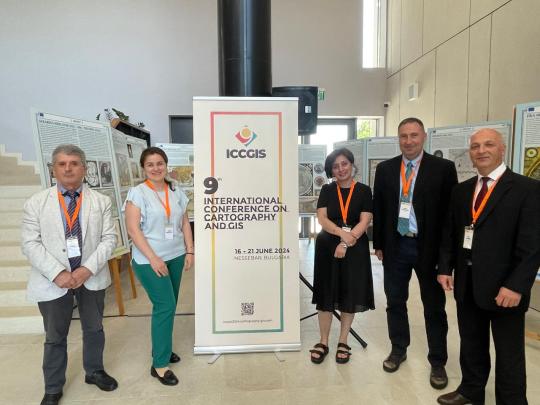
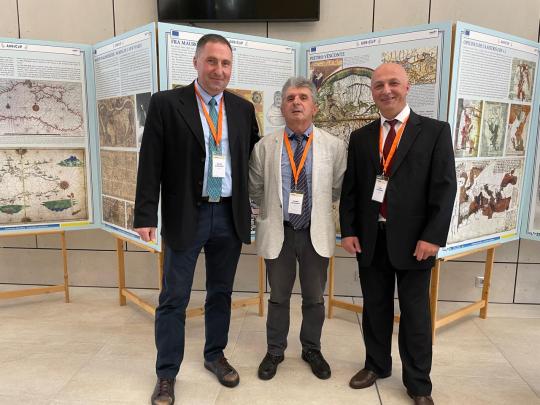
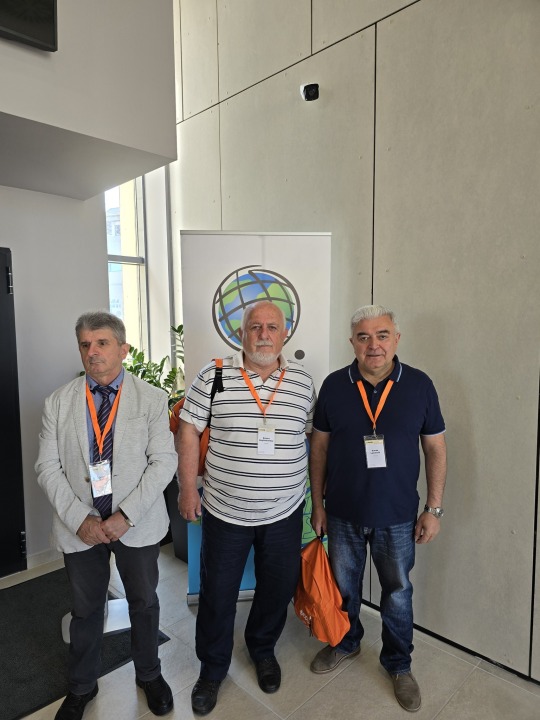

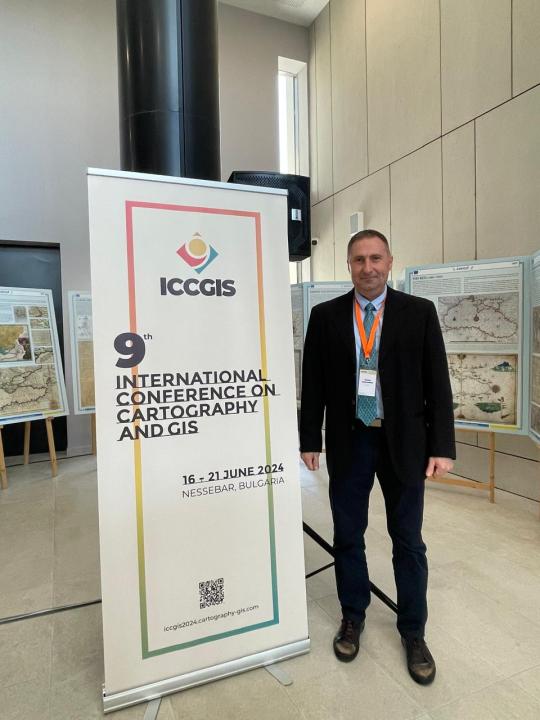
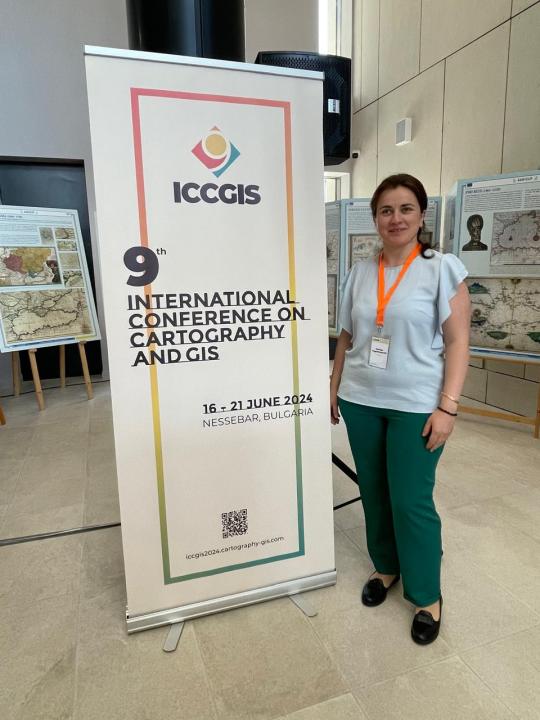
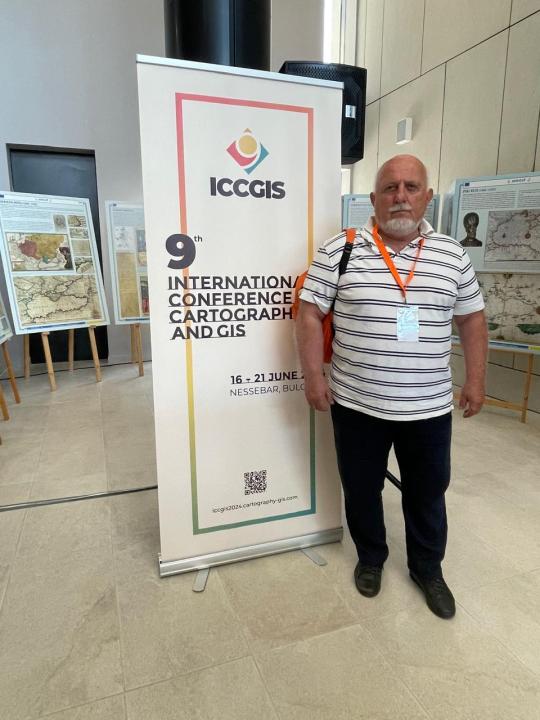
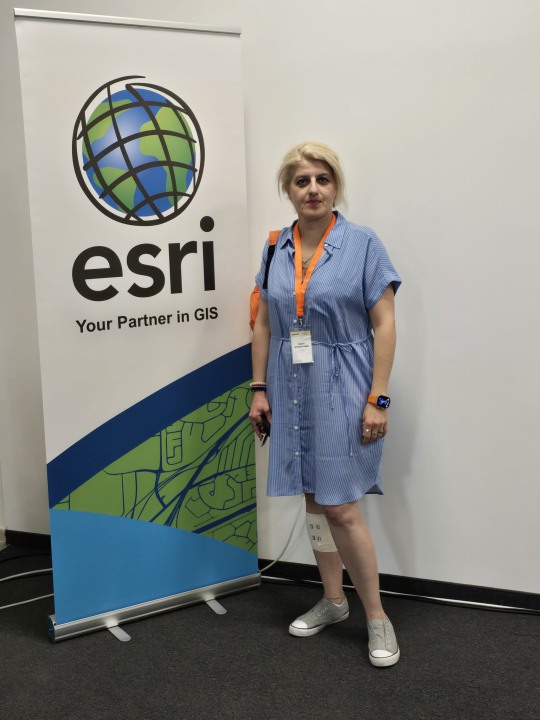
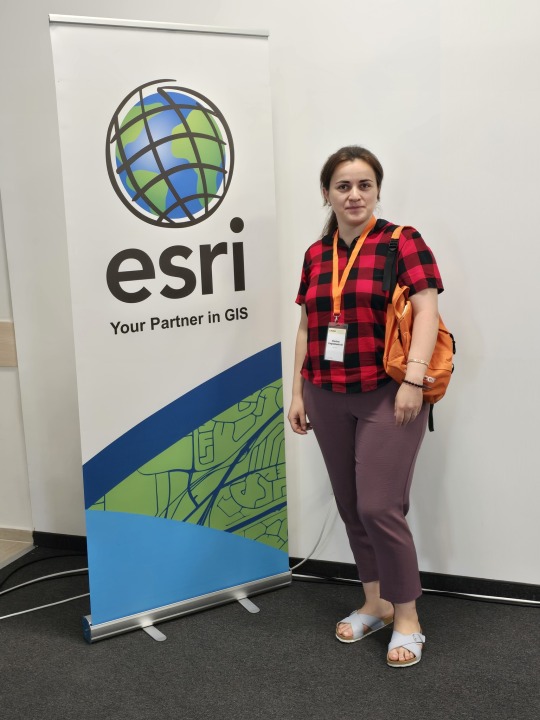

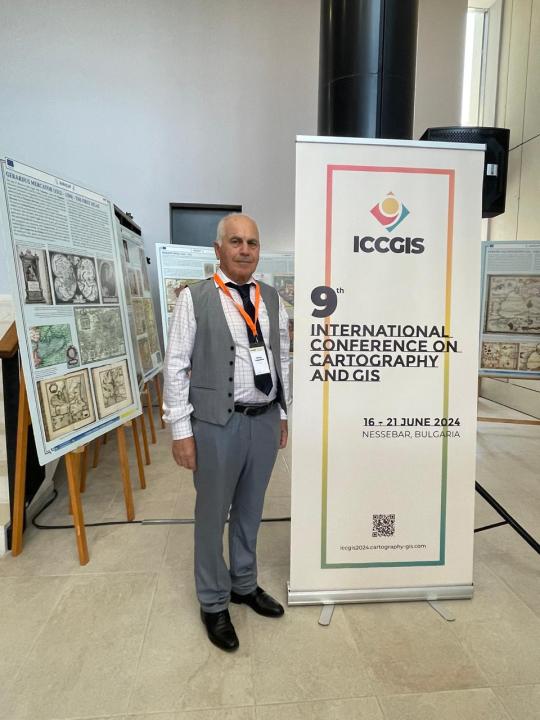
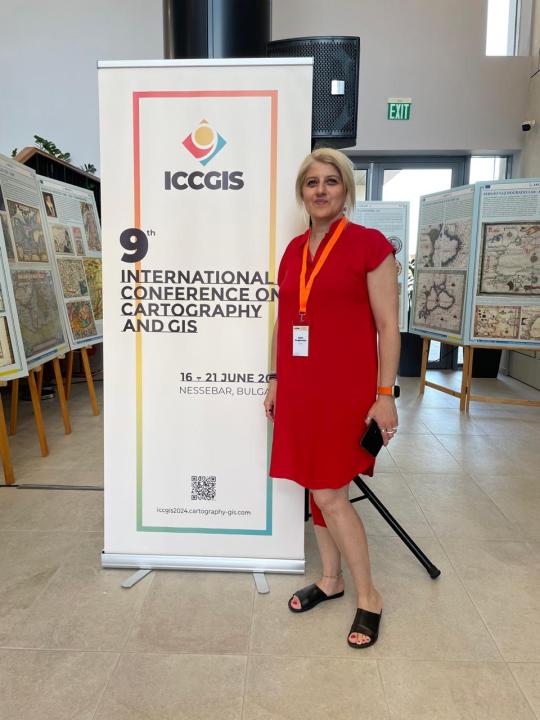
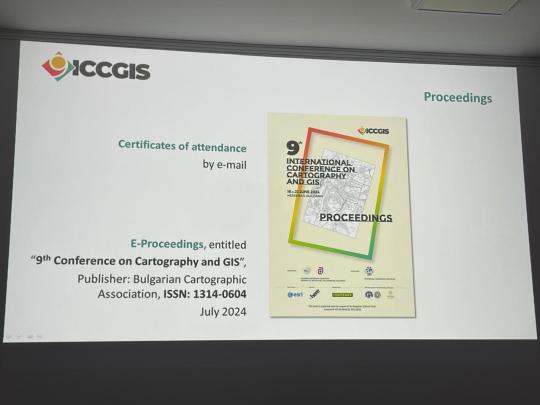
მე-9 საერთაშორისო კონფერენცია კარტოგრაფიისა და GIS-ის შესახებ
9th INTERNATIONAL CONFERENCE ON CARTOGRAPHY & GIS
კონფერენციის მუშაობაში მონაწილეობა მიიღო ქართველ მეცნიერთა 12 წევრიანმა ჯგუფმა. ჯგუფში შედიოდნენ ალექსანდრე ასლანიკაშვილის სახელობის საქართველოს კარტოგრაფთა ასოციაციის წევრები (ასოციაციის პრეზიდენტი, თენგიზ გორდეზიანი, ვიცე პრეზიდენტები: ზურაბ ლაოშვილი, თედო გორგოძე და გოჩა გუძუაძე, გენერალური მდივანი საბა მოდებაძე და სწავლული მდივანი მარიამ გაგოშაშვილი). კონფერენციაზე მოხსენებები წარმოადგინეს: თენგიზ გორდეზიანმა, საბა მოდებაძემ, გოჩა გუძუაძემ (2 მოხსენება), რობერტ მაღლაკელიძემ, ნიკოლოზ კაპანაძემ, მარიამ გაგოშაშვილმა (ივანე ჯავახიშვილის სახელობის თბილისის სახელმწიფო უნივერსიტეტი), სოფიო გორგიჯანიძემ (2 მოხსენება, ჰიდრომეტეოროლოგიის ინსტიტუტი), რევაზ თოლორდავამ (სოხუმის სახელმწიფო უნივერსიტეტი), ზურაბ ლაოშვილმა (საქართველოს ტექნიკური უნივერსიტეტი), ნატო მაისურაძემ (საქართველოს გარემოს დაცვისა და სოფლის მეურნეობის სამინისტრო). ქართველ მეცნიერთა მოხსენებებმა მოიცვა შემდეგი სფეროები: თეორიული კარტოგრაფია, თემატური კარტოგრაფია, საკადასტრო კარტოგრაფია, გეოინფორმაციული სისტემები პრაქტიკაში, სასკოლო კარტოგრაფია, სამხედრო კარტოგრაფია, თანამედროვე გეოდინამიური პროცესების კარტოგრაფირება, გეოეკოლოგიური კარტოგრაფირება. ქართველ მეცნიერთა პრეზენტაციებმა დიდი მოწონება დაიმსახურა. კონფერენციის მასალები გამოქვეყნდება კრებულის ფორმატში, რომელიც ინდექსირებული იქნება საერთაშორისო ბაზაში Web of Science-ში. კონფერენციის მუშაობაში მონაწილე ქვეყნებს შორის საქართველოს დელეგაცია რაოდენობრივად მხოლოდ კონფერენციის ორგანიზატორ ბულგარეთის დელეგაციას და ჩეხეთის რესპუბლიკის დელეგაციას ჩამორჩებოდა.
The conference was attended by a 12-member group of Georgian scientists. The group included members of the Alexander Aslanikashvili Georgian Cartographers Association (Association President Tengiz Gordeziani, Vice Presidents Zurab Laoshvili, Tedo Gorgodze, and Gocha Gudzuadze, General Secretary Saba Modebadze, and Scientific Secretary Mariam Gagoshashvili). Presentations were made by Tengiz Gordeziani, Saba Modebadze, Gocha Gudzuadze (2 presentations), Robert Maghlakelidze, Nikoloz Kapanadze, Mariam Gagoshashvili (Ivane Javakhishvili Tbilisi State University), Sofio Gorgijanidze (2 presentations, Institute of Hydrometeorology), Revaz Tolordava (Sokhumi State University), Zurab Laoshvili (Georgian Technical University), and Nato Maisuradze (Ministry of Environmental Protection and Agriculture of Georgia). The presentations covered areas such as theoretical cartography, thematic cartography, cadastral cartography, GIS practice, school cartography, military cartography, the cartography of modern geodynamic processes, and geoecological cartography. The presentations by the Georgian scientists were well-received. The conference materials will be published in a collection indexed in the international database Web of Science. Among the countries participating in the conference, the Georgian delegation was quantitatively behind only the delegations of Bulgaria, the conference organizer, and the Czech Republic.
#tumblr#like#follow#photo#conference#cartography#GIS#Nessebar#Bulgaria#Georgia#georgian#delegation#ICCGIS#ESRI#ICA
0 notes
Text
A new computational technique could make it easier to engineer useful proteins
New Post has been published on https://sunalei.org/news/a-new-computational-technique-could-make-it-easier-to-engineer-useful-proteins/
A new computational technique could make it easier to engineer useful proteins

To engineer proteins with useful functions, researchers usually begin with a natural protein that has a desirable function, such as emitting fluorescent light, and put it through many rounds of random mutation that eventually generate an optimized version of the protein.
This process has yielded optimized versions of many important proteins, including green fluorescent protein (GFP). However, for other proteins, it has proven difficult to generate an optimized version. MIT researchers have now developed a computational approach that makes it easier to predict mutations that will lead to better proteins, based on a relatively small amount of data.
Using this model, the researchers generated proteins with mutations that were predicted to lead to improved versions of GFP and a protein from adeno-associated virus (AAV), which is used to deliver DNA for gene therapy. They hope it could also be used to develop additional tools for neuroscience research and medical applications.
“Protein design is a hard problem because the mapping from DNA sequence to protein structure and function is really complex. There might be a great protein 10 changes away in the sequence, but each intermediate change might correspond to a totally nonfunctional protein. It’s like trying to find your way to the river basin in a mountain range, when there are craggy peaks along the way that block your view. The current work tries to make the riverbed easier to find,” says Ila Fiete, a professor of brain and cognitive sciences at MIT, a member of MIT’s McGovern Institute for Brain Research, director of the K. Lisa Yang Integrative Computational Neuroscience Center, and one of the senior authors of the study.
Regina Barzilay, the School of Engineering Distinguished Professor for AI and Health at MIT, and Tommi Jaakkola, the Thomas Siebel Professor of Electrical Engineering and Computer Science at MIT, are also senior authors of an open-access paper on the work, which will be presented at the International Conference on Learning Representations in May. MIT graduate students Andrew Kirjner and Jason Yim are the lead authors of the study. Other authors include Shahar Bracha, an MIT postdoc, and Raman Samusevich, a graduate student at Czech Technical University.
Optimizing proteins
Many naturally occurring proteins have functions that could make them useful for research or medical applications, but they need a little extra engineering to optimize them. In this study, the researchers were originally interested in developing proteins that could be used in living cells as voltage indicators. These proteins, produced by some bacteria and algae, emit fluorescent light when an electric potential is detected. If engineered for use in mammalian cells, such proteins could allow researchers to measure neuron activity without using electrodes.
While decades of research have gone into engineering these proteins to produce a stronger fluorescent signal, on a faster timescale, they haven’t become effective enough for widespread use. Bracha, who works in Edward Boyden’s lab at the McGovern Institute, reached out to Fiete’s lab to see if they could work together on a computational approach that might help speed up the process of optimizing the proteins.
“This work exemplifies the human serendipity that characterizes so much science discovery,” Fiete says. “It grew out of the Yang Tan Collective retreat, a scientific meeting of researchers from multiple centers at MIT with distinct missions unified by the shared support of K. Lisa Yang. We learned that some of our interests and tools in modeling how brains learn and optimize could be applied in the totally different domain of protein design, as being practiced in the Boyden lab.”
For any given protein that researchers might want to optimize, there is a nearly infinite number of possible sequences that could generated by swapping in different amino acids at each point within the sequence. With so many possible variants, it is impossible to test all of them experimentally, so researchers have turned to computational modeling to try to predict which ones will work best.
In this study, the researchers set out to overcome those challenges, using data from GFP to develop and test a computational model that could predict better versions of the protein.
They began by training a type of model known as a convolutional neural network (CNN) on experimental data consisting of GFP sequences and their brightness — the feature that they wanted to optimize.
The model was able to create a “fitness landscape” — a three-dimensional map that depicts the fitness of a given protein and how much it differs from the original sequence — based on a relatively small amount of experimental data (from about 1,000 variants of GFP).
These landscapes contain peaks that represent fitter proteins and valleys that represent less fit proteins. Predicting the path that a protein needs to follow to reach the peaks of fitness can be difficult, because often a protein will need to undergo a mutation that makes it less fit before it reaches a nearby peak of higher fitness. To overcome this problem, the researchers used an existing computational technique to “smooth” the fitness landscape.
Once these small bumps in the landscape were smoothed, the researchers retrained the CNN model and found that it was able to reach greater fitness peaks more easily. The model was able to predict optimized GFP sequences that had as many as seven different amino acids from the protein sequence they started with, and the best of these proteins were estimated to be about 2.5 times fitter than the original.
“Once we have this landscape that represents what the model thinks is nearby, we smooth it out and then we retrain the model on the smoother version of the landscape,” Kirjner says. “Now there is a smooth path from your starting point to the top, which the model is now able to reach by iteratively making small improvements. The same is often impossible for unsmoothed landscapes.”
Proof-of-concept
The researchers also showed that this approach worked well in identifying new sequences for the viral capsid of adeno-associated virus (AAV), a viral vector that is commonly used to deliver DNA. In that case, they optimized the capsid for its ability to package a DNA payload.
“We used GFP and AAV as a proof-of-concept to show that this is a method that works on data sets that are very well-characterized, and because of that, it should be applicable to other protein engineering problems,” Bracha says.
The researchers now plan to use this computational technique on data that Bracha has been generating on voltage indicator proteins.
“Dozens of labs having been working on that for two decades, and still there isn’t anything better,” she says. “The hope is that now with generation of a smaller data set, we could train a model in silico and make predictions that could be better than the past two decades of manual testing.”
The research was funded, in part, by the U.S. National Science Foundation, the Machine Learning for Pharmaceutical Discovery and Synthesis consortium, the Abdul Latif Jameel Clinic for Machine Learning in Health, the DTRA Discovery of Medical Countermeasures Against New and Emerging threats program, the DARPA Accelerated Molecular Discovery program, the Sanofi Computational Antibody Design grant, the U.S. Office of Naval Research, the Howard Hughes Medical Institute, the National Institutes of Health, the K. Lisa Yang ICoN Center, and the K. Lisa Yang and Hock E. Tan Center for Molecular Therapeutics at MIT.
0 notes
Text
A new computational technique could make it easier to engineer useful proteins
New Post has been published on https://thedigitalinsider.com/a-new-computational-technique-could-make-it-easier-to-engineer-useful-proteins/
A new computational technique could make it easier to engineer useful proteins
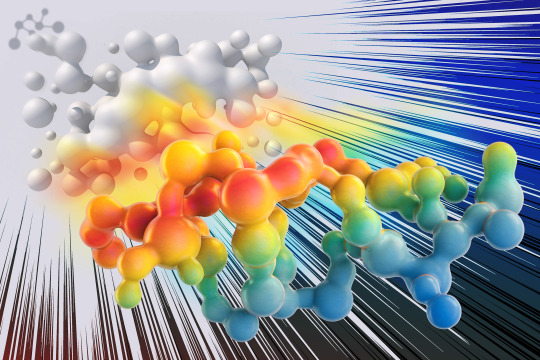

To engineer proteins with useful functions, researchers usually begin with a natural protein that has a desirable function, such as emitting fluorescent light, and put it through many rounds of random mutation that eventually generate an optimized version of the protein.
This process has yielded optimized versions of many important proteins, including green fluorescent protein (GFP). However, for other proteins, it has proven difficult to generate an optimized version. MIT researchers have now developed a computational approach that makes it easier to predict mutations that will lead to better proteins, based on a relatively small amount of data.
Using this model, the researchers generated proteins with mutations that were predicted to lead to improved versions of GFP and a protein from adeno-associated virus (AAV), which is used to deliver DNA for gene therapy. They hope it could also be used to develop additional tools for neuroscience research and medical applications.
“Protein design is a hard problem because the mapping from DNA sequence to protein structure and function is really complex. There might be a great protein 10 changes away in the sequence, but each intermediate change might correspond to a totally nonfunctional protein. It’s like trying to find your way to the river basin in a mountain range, when there are craggy peaks along the way that block your view. The current work tries to make the riverbed easier to find,” says Ila Fiete, a professor of brain and cognitive sciences at MIT, a member of MIT’s McGovern Institute for Brain Research, director of the K. Lisa Yang Integrative Computational Neuroscience Center, and one of the senior authors of the study.
Regina Barzilay, the School of Engineering Distinguished Professor for AI and Health at MIT, and Tommi Jaakkola, the Thomas Siebel Professor of Electrical Engineering and Computer Science at MIT, are also senior authors of an open-access paper on the work, which will be presented at the International Conference on Learning Representations in May. MIT graduate students Andrew Kirjner and Jason Yim are the lead authors of the study. Other authors include Shahar Bracha, an MIT postdoc, and Raman Samusevich, a graduate student at Czech Technical University.
Optimizing proteins
Many naturally occurring proteins have functions that could make them useful for research or medical applications, but they need a little extra engineering to optimize them. In this study, the researchers were originally interested in developing proteins that could be used in living cells as voltage indicators. These proteins, produced by some bacteria and algae, emit fluorescent light when an electric potential is detected. If engineered for use in mammalian cells, such proteins could allow researchers to measure neuron activity without using electrodes.
While decades of research have gone into engineering these proteins to produce a stronger fluorescent signal, on a faster timescale, they haven’t become effective enough for widespread use. Bracha, who works in Edward Boyden’s lab at the McGovern Institute, reached out to Fiete’s lab to see if they could work together on a computational approach that might help speed up the process of optimizing the proteins.
“This work exemplifies the human serendipity that characterizes so much science discovery,” Fiete says. “It grew out of the Yang Tan Collective retreat, a scientific meeting of researchers from multiple centers at MIT with distinct missions unified by the shared support of K. Lisa Yang. We learned that some of our interests and tools in modeling how brains learn and optimize could be applied in the totally different domain of protein design, as being practiced in the Boyden lab.”
For any given protein that researchers might want to optimize, there is a nearly infinite number of possible sequences that could generated by swapping in different amino acids at each point within the sequence. With so many possible variants, it is impossible to test all of them experimentally, so researchers have turned to computational modeling to try to predict which ones will work best.
In this study, the researchers set out to overcome those challenges, using data from GFP to develop and test a computational model that could predict better versions of the protein.
They began by training a type of model known as a convolutional neural network (CNN) on experimental data consisting of GFP sequences and their brightness — the feature that they wanted to optimize.
The model was able to create a “fitness landscape” — a three-dimensional map that depicts the fitness of a given protein and how much it differs from the original sequence — based on a relatively small amount of experimental data (from about 1,000 variants of GFP).
These landscapes contain peaks that represent fitter proteins and valleys that represent less fit proteins. Predicting the path that a protein needs to follow to reach the peaks of fitness can be difficult, because often a protein will need to undergo a mutation that makes it less fit before it reaches a nearby peak of higher fitness. To overcome this problem, the researchers used an existing computational technique to “smooth” the fitness landscape.
Once these small bumps in the landscape were smoothed, the researchers retrained the CNN model and found that it was able to reach greater fitness peaks more easily. The model was able to predict optimized GFP sequences that had as many as seven different amino acids from the protein sequence they started with, and the best of these proteins were estimated to be about 2.5 times fitter than the original.
“Once we have this landscape that represents what the model thinks is nearby, we smooth it out and then we retrain the model on the smoother version of the landscape,” Kirjner says. “Now there is a smooth path from your starting point to the top, which the model is now able to reach by iteratively making small improvements. The same is often impossible for unsmoothed landscapes.”
Proof-of-concept
The researchers also showed that this approach worked well in identifying new sequences for the viral capsid of adeno-associated virus (AAV), a viral vector that is commonly used to deliver DNA. In that case, they optimized the capsid for its ability to package a DNA payload.
“We used GFP and AAV as a proof-of-concept to show that this is a method that works on data sets that are very well-characterized, and because of that, it should be applicable to other protein engineering problems,” Bracha says.
The researchers now plan to use this computational technique on data that Bracha has been generating on voltage indicator proteins.
“Dozens of labs having been working on that for two decades, and still there isn’t anything better,” she says. “The hope is that now with generation of a smaller data set, we could train a model in silico and make predictions that could be better than the past two decades of manual testing.”
The research was funded, in part, by the U.S. National Science Foundation, the Machine Learning for Pharmaceutical Discovery and Synthesis consortium, the Abdul Latif Jameel Clinic for Machine Learning in Health, the DTRA Discovery of Medical Countermeasures Against New and Emerging threats program, the DARPA Accelerated Molecular Discovery program, the Sanofi Computational Antibody Design grant, the U.S. Office of Naval Research, the Howard Hughes Medical Institute, the National Institutes of Health, the K. Lisa Yang ICoN Center, and the K. Lisa Yang and Hock E. Tan Center for Molecular Therapeutics at MIT.
#000#acids#ai#algae#amino acids#applications#approach#Artificial Intelligence#Bacteria#Best Of#Biological engineering#Brain#Brain and cognitive sciences#brain research#brains#Cells#change#CNN#Collective#computer#Computer Science#Computer Science and Artificial Intelligence Laboratory (CSAIL)#Computer science and technology#conference#czech#data#Defense Advanced Research Projects Agency (DARPA)#Design#DNA#Electrical Engineering&Computer Science (eecs)
0 notes
Text
Meetings are the cornerstone of business growth and decision-making. But when conducted in the right environment, these meetings transform from mere discussions to collaborative experiences that can set the tone for monumental decisions. Enter Prague – a city that offers a harmonious blend of history, culture, and modern business infrastructure, making it the ultimate locale for hosting impactful meetings.
Historic Halls vs. Modern Meeting Spaces:
Prague’s landscape is dotted with diverse venues that bring their own unique charm to business meetings:
Historic Halls: Imagine discussing future strategies in a baroque hall, where every corner whispers tales of ancient European diplomacy. These venues, like the Lobkowicz Palace, provide an ambiance imbued with gravitas, helping anchor discussions in a grand historical context.
Modern Spaces: On the other hand, establishments like the Prague Congress Centre offer state-of-the-art facilities, with ultra-modern amenities, ensuring meetings are efficient and tech-driven.
This choice between the historic and the contemporary allows businesses to set the perfect tone for their discussions.
Prague Eventery’s Expertise:
With a city as diverse as Prague, having a guide can make all the difference. Prague Eventery, with its intricate understanding of the city’s pulse, ensures that every meeting is tailored to the client’s specific needs:
Location Scouting: Whether you desire a view of the Vltava or the proximity to the bustling Old Town Square, the perfect venue is handpicked.
Technical Mastery: From seamless video conferencing across continents to high-definition presentations, every technical detail is flawlessly executed.
Ambiance Creation: Lighting, acoustics, and décor – every element is tweaked to perfection to create the desired atmosphere for productive conversations.
Real-Life Scenario – A Meeting to Remember:
Last summer, a multinational pharmaceutical company approached Prague Eventery to organize a high-stakes meeting. The objective was to finalize a groundbreaking merger. Given the gravity of the situation, Prague Eventery proposed the Clementinum’s historic halls, an architectural marvel and once a part of the Charles University.
During the event, attendees were treated to a seamless blend of history and modern business amenities. Post-meeting, a private chamber orchestra played classic Czech compositions, allowing attendees to relax and reflect upon the day’s discussions.
The result? A successful merger and a memorable experience that attendees still fondly recall.
Extended Services – Making the Most of Prague:
While the meeting is pivotal, the overall experience of attendees is equally crucial. Prague Eventery ensures that attendees are treated to:
Guided Tours: A stroll through the historic Old Town, or a private tour of the Prague Castle, ensuring attendees experience the city’s essence.
Networking Events: Organized at iconic locales, these events blend business with pleasure, allowing attendees to forge lasting connections amidst Prague’s beauty.
Culinary Experiences: From traditional Czech cuisine to global delicacies, attendees are taken on a gastronomic journey that delights and surprises.
Conclusion:
When business meets culture in a setting as rich and diverse as Prague, meetings transcend their primary function. They become experiences that shape decisions, foster connections, and leave an indelible mark on attendees. With a partner like Prague Eventery, businesses can unlock the true potential of what a meeting in Prague can offer.
1 note
·
View note
Text
Aerospace Robotics Market May Set New Epic Growth Story

Latest business intelligence report released on Global Aerospace Robotics Market, covers different industry elements and growth inclinations that helps in predicting market forecast. The report allows complete assessment of current and future scenario scaling top to bottom investigation about the market size, % share of key and emerging segment, major development, and technological advancements. Also, the statistical survey elaborates detailed commentary on changing market dynamics that includes market growth drivers, roadblocks and challenges, future opportunities, and influencing trends to better understand Aerospace Robotics market outlook.
List of Key Players Profiled in the study includes market overview, business strategies, financials, Development activities, Market Share and SWOT analysis:
Kuka AG (Germany), ABB Group (Switzerland), Fanuc Corporation (Japan), Yaskawa Electric Corporation (Japan), Kawasaki Heavy Industries, Ltd (Japan), Oliver Crispin Robotics Limited (United Kingdom), Gudel AG (Switzerland), Electroimpact Inc. (United States), Universal Robots A/S (Denmark), AV&R Vision & Robotics Inc. (Canada).
Download Free Sample PDF Brochure (Including Full TOC, Table & Figures) @ https://www.advancemarketanalytics.com/sample-report/41573-global-aerospace-robotics-market
Brief Overview on Aerospace Robotics:
The aerospace industry is responsible for some of the greatest technical inventions in human history. The role of robotics in manufacturing of aerospace products is very significant. Robotics plays an important function in aerospace industry like fabrication of aircraft engines, drilling & fastening, sealing & dispensing and others. Aerospace industry is increasingly investing in robots to perform drilling, painting and other tasks on airframes. Robot’s ability to repeatedly position very large aerospace components with a high degree of precision makes sure that the aerospace robotics has potential market growth
Key Market Trends:
Increasing demand for collaborative robots
Recent technological advancements in aerospace robotics
Opportunities:
Human-robot collaboration in aerospace industry
Market Growth Drivers:
Increase in use of robots for efficient aircraft production
Rising use of robotics to handle aircraft orders backlog
Challenges:
High initial investment of implanting robotics
Segmentation of the Global Aerospace Robotics Market:
by Type (Articulated, Cartesian, Others), Application (Drilling, Welding, Painting, Inspection, Others), Technology (Traditional, Collaborative), Component (Controller, Arm Processor, End Effector, Drive, Sensors)
Purchase this Report now by availing up to 10% Discount on various License Type along with free consultation. Limited period offer.
Share your budget and Get Exclusive Discount @: https://www.advancemarketanalytics.com/request-discount/41573-global-aerospace-robotics-market
Geographically, the following regions together with the listed national/local markets are fully investigated:
• APAC (Japan, China, South Korea, Australia, India, and Rest of APAC; Rest of APAC is further segmented into Malaysia, Singapore, Indonesia, Thailand, New Zealand, Vietnam, and Sri Lanka)
• Europe (Germany, UK, France, Spain, Italy, Russia, Rest of Europe; Rest of Europe is further segmented into Belgium, Denmark, Austria, Norway, Sweden, The Netherlands, Poland, Czech Republic, Slovakia, Hungary, and Romania)
• North America (U.S., Canada, and Mexico)
• South America (Brazil, Chile, Argentina, Rest of South America)
• MEA (Saudi Arabia, UAE, South Africa)Furthermore, the years considered for the study are as follows:
Historical data – 2017-2022
The base year for estimation – 2022
Estimated Year – 2023
Forecast period** – 2023 to 2028 [** unless otherwise stated]
Browse Full in-depth TOC @: https://www.advancemarketanalytics.com/reports/41573-global-aerospace-robotics-market
Summarized Extracts from TOC of Global Aerospace Robotics Market Study Chapter 1: Exclusive Summary of the Aerospace Robotics market
Chapter 2: Objective of Study and Research Scope the Aerospace Robotics market
Chapter 3: Porters Five Forces, Supply/Value Chain, PESTEL analysis, Market Entropy, Patent/Trademark Analysis
Chapter 4: Market Segmentation by Type, End User and Region/Country 2016-2027
Chapter 5: Decision Framework
Chapter 6: Market Dynamics- Drivers, Trends and Challenges
Chapter 7: Competitive Landscape, Peer Group Analysis, BCG Matrix & Company Profile
Chapter 8: Appendix, Methodology and Data Source
Buy Full Copy Aerospace RoboticsMarket – 2021 Edition @ https://www.advancemarketanalytics.com/buy-now?format=1&report=41573
Contact US :
Craig Francis (PR & Marketing Manager)
AMA Research & Media LLP
Unit No. 429, Parsonage Road Edison, NJ
New Jersey USA – 08837
Phone: +1 201 565 3262, +44 161 818 8166
[email protected]
#Global Aerospace Robotics Market#Aerospace Robotics Market Demand#Aerospace Robotics Market Trends#Aerospace Robotics Market Analysis#Aerospace Robotics Market Growth#Aerospace Robotics Market Share#Aerospace Robotics Market Forecast#Aerospace Robotics Market Challenges
0 notes
Text
International Students’ Day — Honouring and Celebrating Students

On 17th November, 1939, the Nazi troops stormed the University of Prague in then-Czechoslovakia, now known as the Czech Republic, to curb the protests against the Nazi occupation of Czechoslovakia. On this unfortunate day, nine students and professors were brutally murdered by the Nazi troops. International Students’ Day is observed annually on 17th November to honour these martyred students and applaud the bravery and importance of student unions around the globe.
Students are the future of the country and should be given the freedom to explore ideas. In today’s era, students are using social media to encourage discussion on previously ignored issues. Talks on the LGBTQIA+ community, mental health, and marginalized communities have had a great impact on the cultural zeitgeist. The change in the media, books and entertainment is a reflection of that, where people from marginalized communities are getting better representation than ever before.
Child Help Foundation knowing the importance of students for the country has provided education to children throughout the nation. To celebrate students, here are some reasons why student councils are important:
Students Get More Socially Conscious Than Ever Before

It is increasingly evident that students today are much more active on society’s issues than their yesteryear counterparts. Students are more well-informed on global conflicts and other issues than ever before. Discussions around politics, gender identities, racial discrimination and caste-based issues are getting more common on college campuses, which is thanks to student councils around the world. This presents a good hope for the future of the country as more students get socially conscious, the better would be the state of the nation.

Mental Health, Peer Pressure and Bullying were seen as trivial issues in the past. However, student unions have given a platform to students to grieve their issues to a larger audience. These platforms have the potential to change society’s stance and raise awareness about previously trivialized issues.

Student Unions hone the leadership skills of the students involved, which is important as students are the leaders of the future. Leaders of these unions have the responsibility of maintaining peace and resolving conflicts, skills which are very important for the future of the country as well as their further aspirations.

In student unions, children from different backgrounds come together to hold discussions. Class, Religion, Gender, Race, and Caste barriers are put aside for a common cause. This cohesion creates unity and maintains social harmony, building trust among different groups.

Student Councils not only talk about issues but also organize events for colleges like festivals, fundraisers and competitions. This involves planning, diplomacy, funds management, and technical skills. Colleges are organizing festivals which seem beyond the capabilities of students. Involvement in these activities helps students to learn skills which could be fruitful for their future endeavours.
Knowing the importance of students, Child Help Foundation has helped 4,86,141 children with their education. Child Help Foundation also provides these schools with Mini Science Centres and organizes sessions and activities for them to increase their potential.
Thank you for taking the time to read the article. Make sure to share it with all your friends and family members.
#filaantro#fundraising#nonprofits#charity#raise funds#donations#education#crowdfunding#donate#volunteering
0 notes
Note
where are you originally from? if answering this put you in an unsafe position please don't
Ah, that's a very long story.
I have lived in Germany as long as I can remember so I consider it to be my home country & the culture I grew up/identify with.
So If you ask me, I'd say I'm "from" the city of Kiel in Schleswig-Hollstein, though I've lived all over the Republic.
I was, however, born in Havanna, though I only lived there for 10 months. (there was a famine in the mid 90s which motivated my parents to flee, so technically we came to europe as refugees, though my mom had lived in europe before as a kid.)
I do speak some Spanish but I can't write it and my vocabulary is not enough for sophisticated discussion.
My father's family is from northern Spain, though they came to Cuba in the 1900s. My mom usually says she's 'half czech, half cuban'.
With the Czech & Spanish(on father's side) part of the family we know the particular tiny farm village the family is from where they have presumably lived since the migration period/dark ages.
He's from Galicia (that bit that sticks out a little next to portugal) which are actually the closest relatives of British islanders outside of britain. They play bagpipe and everything. So my father inda looks like your typical south european guy like spanish/italian/greek/south french etc but with those characteristic cheek bones & nose shapes you see in the british. Chubbier jenna coleman with curly hair.
That lead to an interesting situation where I commented under some American discussing their DNA test results "aww, my results would be boring, we're all from little cow villages europe" but the American person was actually jealous that I knew the exact places. So I guess it depends on your perspective.
It certainly is a privilege when you hear these stories of ppl being prevented from visiting where their granparents lived, whereas I could just pop over any time without even having border controls. Once time we drove past the area when going to prague for something & mom pointed out the mountains near that village (apparently my czech grandpa used to joke that they look like boobs and... he wasn't wrong XD)
My parents and I are banned from Cuba for life, though, if I recall correctly. Not my siblings who were born in Germany, however, one of my sisters visited once (result: the tree on the campus of the university my mom went to is alot bigger, and the beach our parents kept talking up really IS that pretty, but aside from that, everything got way worse since they left)
As for the Cuban grandma, she was adopted by a an afro-cuban lady who she considers her real mom, but he backstory there was, insofar as we're aware, that Dad fled Germany as a young man when the Nazis took over, got a girlfriend, and then left to go back & check on his family, giving the instruction that the kid be named 'victoria' if its a girl. (in honor of the defeat of the Nazis)
Alas, my grandma's bio mom got a proposal from a wealthy mexican guy while her bf was away, and ended up hiding the pregnancy and then abandoning the baby in the Caribbean. Mexican guy never found out she had a previous boyfriend or child.
The dad came to look for her a few times, but grandma was always away (once in Moscow for university, and then living in Prague with her husband), so we never found him.
The adopted mom was the one who taught my mom to cook as a kid, so this resulted in a situation where we had African Week at the university and I went there thinking I'd get to try something totally new ... and it's just mom's yellow rice with green beans and plantains fritters, but with more Chili.
So there's a lot of twists & turns, but in the end I'm basically just european, nothing too exciting really.
0 notes